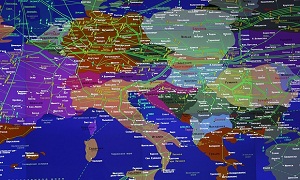Europe places bets on natural gas to secure energy future

The future of Europe’s energy supply is to rely heavily on natural gas for the coming two decades and beyond, according to a new strategy set out on Tuesday by the European commission.
The plans were immediately attacked by green campaigners, who contrasted the continued role of fossil fuels with commitments to cut carbon dioxide made by the EU at the Paris climate summit two months ago.
Gas will have to be imported, from sources including Russia, Norway, Qatar and other Gulf states, under plans set out in the commission’s “Sustainable EnergySecurity Package”.
This will require tens of billions of euros of investment in infrastructure, including new cross-border pipelines, and the development of terminals for the import of liquefied natural gas (LNG). Most LNG currently comes from the Gulf but which in future could also be supplied from the shale fields of the US.
Miguel Arias Cañete, EU climate change commissioner, acknowledged theproblems with gas supply that have haunted Europe in the recent past, such as Russia turning off supplies to the Ukraine for political ends. But he said that the renewed focus on diversifying supply and on constructing storage facilities would improve energy security.
“After the gas crises of 2006 and 2009 that left many millions out in the cold, we said never again. But we are still far too vulnerable to major disruption of gas supplies, and the political tensions on our borders are a sharp reminder that this problem will not just go away,” he said. “Today’s proposals are about a reliable, competitive and flexible system in which energy flows across borders and consumers reap the benefits. They are about standing together to protect the most vulnerable. They are about securing our clean energy future.”
While gas is a lower carbon fuel than coal, the implication of such a massive new investment in gas infrastructure is that its use will continue for decades to come. This could open up conflicts with the EU’s targets on reducing greenhouse gas emissions, enshrined in last December’s Paris accord, which the EU played a major role in bringing about.
Dustin Benton, head of energy and resources at the Green Alliance thinktank, told the Guardian: “This doesn’t deliver on the commission’s promise for an efficiency-first energy security strategy. Better markets for gas can help keep EU energy secure if combined with continued renewable energy growth, but this strategy won’t stop us wasting power stations worth of energy.”
A contrast with the Paris agreement, at which the EU pledged to hold future temperature increases to no more than 2C or 1.5C, was inevitable, said Jiri Jerabek, energy policy adviser at Greenpeace EU. “It’s like the Paris agreement never happened, and the commission is stuck on gas, dishing out a costly proposal that will keep Europe hooked on energy imports. Only if Europe focuses on renewables and energy efficiency will Europe meet its climate targets and reduce dependence on foreign supplies.”
Claude Turmes, energy spokesman for the Green MEP grouping in the European parliament, called the strategy “rolling out the red carpet for Gazprom”, Russia’s national energy giant. “The commission is basing its strategy on a huge over-estimation of demand for gas. Instead of pumping millions into projects that are doomed to fail, they should wait until new, more credible estimates for gas demand can be formulated.”
Organisations focused on energy efficiency – under the previous commission, known as one of the “three pillars” of energy policy for 2020 – were disappointed at what they saw as a lack of commitment to reducing energy use. Proponents of renewable energy – another key target under the 2020 plans – also found little cheer in the new package.
Dr David Clarke, chair of a Royal Academy of Engineering group on UK energy policy, told the Guardian that if gas use was to be continued at such levels in Europe, then fledgling technology for capturing and storing greenhouse gas emissions would become essential. He said: “If we are to meet 2050 carbon reduction targets it becomes necessary to completely eliminate CO2 from power generation. The post-2030 use of fossil fuels in power generation becomes increasingly challenging without the ability to implement CCS. Given that a logical part of replacing coal-fired capacity in the 2020s will be to build new gas-fired plant, it is important we progress demonstration of CCS on gas at the earliest opportunity.”
Last November, days ahead of the Paris climate summit, the chancellor,George Osborne, cancelled the government-sponsored £1bn competition to build the first power-station scale CCS plant in the UK. There are now no major CCS projects at an advanced stage in Europe.
About half of Europe’s energy goes to heating and cooling old and leaky buildings, according to the European Insulation Manufacturers Association. Jan te Bos, director general, said: “Buildings are Europe’s largest single user of energy so it is encouraging that the commission published a heating and cooling strategy as part of today’s package. What is needed next are concrete proposals for an EU wide building renovation plan ideally with targets – otherwise the strategy wastes a unique opportunity to properly reduce European dependence on energy imports.”
Source: the guardian

